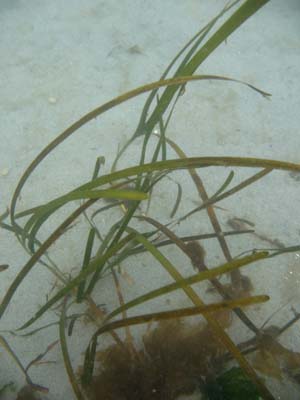
ECOLOGY
Z.marina at 4th of July Beach, Friday Harbor WA. |
||
Value of Seagrass Functional
Economic Seagrass, as an ecosystem, is economically valuable (Constanza, 1997; Carlisle, 2004). Seagrass habitats provide nursery and foraging areas for many commercial and recreational fish and shellfish species, and thus support the production of numerous living marine resources.
Cultural The value of seagrasses, as perceived by humans, has changed historically through time and place (Kenworthy et al., 2006). In the past, seagrasses have been valued because the plants yielded material for various practical purposes. The direct use of seagrass has a long history for a variety of needs. In the seventeenth and eighteenth century, Z. marina seeds were a major food source of the Seri Indians living along the Gulf of California. The Seri harvested the carbohydrate-rich seeds to obtain flour for use in a variety of dishes (Felger et al, 1980). Z. marina seeds, roots and leaf bases have and continue to be a food source in the north-west Pacific, and in South-East Asia. Globally, the net fibres in Z. marina have been used to create cordage and nets. Z. marina has also been used for basket weaving, bedding, clothing, insulation, mulch and high-grade paper (Kenworthy et al., 2006).
© Jessica Smith 2008 |
||
Carlisle. E. (2004) Seagrass research and management in Washington state. Univerity of Washington – School of Marine Affairs. Constanza. R, d'Arge. R, de Groot. R, Farber. S, Grasso, M, Hannon. B, Limburg. K, Naeem S (1997) The value of the world's ecosystem services and natural capital. Nature 387: 253-260. Felger. R, M. Moser, E.Moser. (1980). Seagrasses in Seri Indian culture. Handbook of Seagrass Biology: an ecosystem perspective. Garland STPM Press. New York. Kenworthy. W, Wyllie-Echeverria. S, R. Coles, G. Pergent, C. Pergent-Martini (2006) In: Larkum.A, R.Orth, C.Duarte. (2006). Seagrasses: Biology, Ecology and Conservation. Springer. Romero. J, Kun-Seop. L, Perez. M, Mateo. M, T. Alcoverro (2006) In: Larkum.A, R.Orth, C.Duarte. (2006). Seagrasses: Biology, Ecology and Conservation. Springer. |


